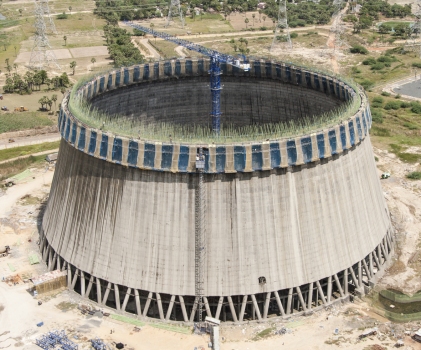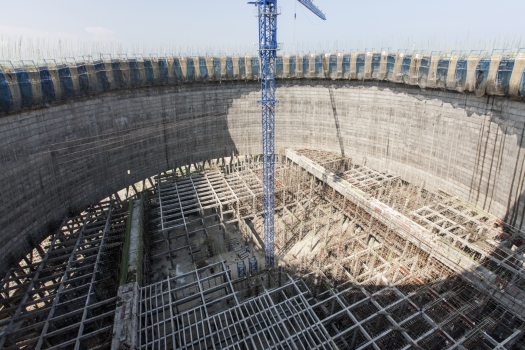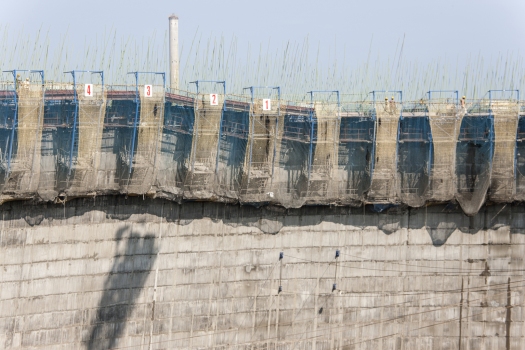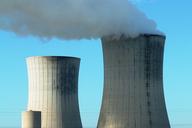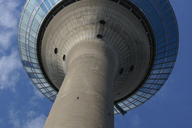India: High-performance cooling tower formed at the double
Increased energy demands in the fast-growing state of Andhra Pradesh in India necessitated the construction of a new coal-fired power plant. Doka had supplied the formwork solution for the construction of the cooling tower, ensuring efficient construction progress in 1-day cycles. Completion was scheduled for late 2014.
The population density of 500 persons per km² in Krishnapatnam, the port city in Andhra Pradesh, is high and rising. In order to meet these increasing energy needs, a new coal-fired power plant was built by Andhra Pradesh Power Development Company Ltd. (APPDCL) with a capacity of 2 x 800 MW. Construction company Tata Projects Ltd. received the megawatt order and entrusted the formwork construction of the cooling tower to Doka with its decades of international experience. The high-performing self-climbing Doka cooling tower formwork SK175 represents the ideal solution for such large-scale projects.
1-day cycle
In total, this project utilised 128 units of cooling tower formwork SK175. The climbing scaffold served as a carrier for the steel formwork, which was transported by a minimum of ten electromechanically driven lifting systems from one concreted section to the next. The formwork was safely guided along the building during the climbing process, regardless of wind speeds and weather conditions.
Compliance with the tightly-specified schedule was a top priority for the customer. The workflows created by Doka engineers enabled the extremely tight timing intervals of just one day to be maintained, ensuring construction progresses right on schedule.
Flexible adjustment, precise forming
The easy-to-handle adjusting spindles enable the cooling tower formwork SK175 to adapt perfectly to every change in inclination. In this way, the maximum attainable angle of inclination amounts to 22 degrees from the vertical. "This allows radii of up to 70 m to be navigated without any adjustments and all commonly occurring geometries during cooling tower construction are covered", explains Andreas Guttenbrunner, Head of the Doka Power Plants Competence Centre.
The individual formwork elements can be precisely adapted to the changing circumference by means of two compensating plates that are attached to both sides of the formwork. A compensating element is removed after six to eight concreting stages. "This extremely flexible system makes it possible to retain all self-climbing units on the tower from the first concreting stage right up to 113th. This avoids both interruptions to working processes as well as time-consuming adaptations", explains Guttenbrunner.
Minimal tolerances
The geometry of the post-construction 172.5 m high cooling tower is characterised by its tapering diameter. The maximum tower diameter of 132 m at the base reduces to 76.4 m at the centre and increases again up to the top ring to 77.4 m. The specified tolerances make high demands in terms of precision when concreting on-site, requiring precise dimensions for the cooling tower formwork. The tolerance on the wall thickness is a maximum of -5 to +10 mm, geometric deviations are only permissible within the range of +/- 50 mm. In addition, the horizontal concrete joints may not protrude by more than 5 mm. Doka cooling tower formwork SK175 is designed for precise adjustment, so that the strict specifications of these tight tolerances are easily met in each concrete section.
Services ensure smooth progress
The experts from the Doka Power Plants Competence Centre organised a special seminar for the site managers of the Tata project in order to ensure that the formwork was constructed smoothly and quickly right from the outset. This gave them the opportunity to consult the customer in advance in all aspects of the construction work as well as to discuss the essential conditions and present their detailed analysis of the formwork solution. The working platforms and scaffolding were delivered to the site punctually in accordance with the previously agreed schedule drawn up in conjunction with the construction management team and were then assembled under the supervision of Doka formwork instructor Vellore Rajasekar. The formwork instructor familiarised the site crew with the specific details of the cooling tower formwork and supported the team during the initial climbing stages.
References
Structure Types
- About this
data sheet - Product-ID
7304 - Published on:
16/12/2015 - Last updated on:
28/01/2016

